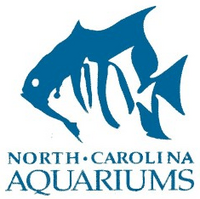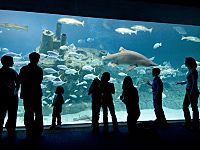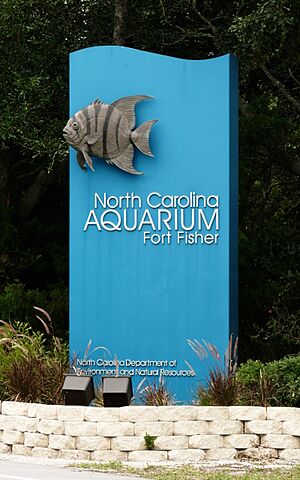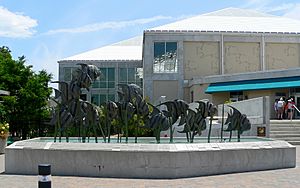North Carolina Aquariums facts for kids
 |
|

A "Live Dive!" program at the North Carolina Aquarium at Pine Knoll Shores.
|
|
| Date opened | 1976 |
|---|---|
| Volume of largest tank | Pine Knoll Shores: 306,000 US gallons (1,160,000 L; 255,000 imp gal)
Roanoke Island: 285,000 US gallons (1,080,000 L; 237,000 imp gal) Fort Fisher: 235,000 US gallons (890,000 L; 196,000 imp gal) |
| Total volume of tanks | Fort Fisher: 455,000 US gallons (1,720,000 L; 379,000 imp gal)
Pine Knoll Shores: 430,000 US gallons (1,600,000 L; 360,000 imp gal) Roanoke Island: 410,000 US gallons (1,600,000 L; 340,000 imp gal) |
| Memberships | AZA |
| Website | www.ncaquariums.com |
The North Carolina Aquariums are three awesome places where you can explore the underwater world! These aquariums are located in Kure Beach, Roanoke Island, and Pine Knoll Shores. They have been open since 1976 and are run by the North Carolina Department of Natural and Cultural Resources.
All three aquariums are special because they are approved by the Association of Zoos and Aquariums. This means they meet high standards for animal care and education. When you visit, you can enjoy exciting dive shows, get close to live animals, and watch them being fed!
Contents
North Carolina Aquarium at Fort Fisher
The North Carolina Aquarium at Fort Fisher is in Kure Beach. Its main goal is to teach visitors about the amazing water life in the Cape Fear area. This aquarium has even been called one of the "Best Aquariums in the United States" by the Travel Channel! It's also one of the top attractions in North Carolina.
Explore Freshwater Life
When you first arrive, you'll enter the Cape Fear Conservatory. This is a big, tree-filled area that shows you freshwater animals. You'll see streams, ponds, and swamps. These habitats are home to frogs, snakes, bass, catfish, and perch. Look closely, and you might spot box turtles hiding in the plants.
One of the biggest exhibits here features alligators that live naturally in North Carolina. Since 2009, you can also see a rare albino alligator! In 2006, the aquarium added an exhibit with venomous snakes from the region. These include different types of rattlesnakes, copperheads, and cottonmouths.
Discover Coastal Waters
The Coastal Waters Gallery lets you get hands-on! You can touch sea urchins, horseshoe crabs, whelks, and other creatures in the Coquina Outcrop Touch Pool. The Masonboro Inlet Jetty exhibit shows fish that live around rocky jetties. You can also see an indoor salt marsh, a sea horse habitat, and a display about loggerhead sea turtles.
Journey to the Open Ocean
In the Open Oceans Gallery, you'll find Sharkstooth Ledge. This area features fish from offshore North Carolina, like pufferfish, hogfish, and filefish. You'll also see octopus, jellyfish, and corals that live in the state's waters.
A special multimedia exhibit, opened in 2011, focuses on the megalodon. This was a huge, extinct shark that ate whales! The exhibit has cool projections on a giant curved screen. It also includes interactive holograms and touch-screen games.
Cape Fear Shoals: A Giant Tank
The biggest saltwater exhibit at the aquarium is Cape Fear Shoals. It holds an amazing 235,000 US gallons (890,000 L; 196,000 imp gal) of water! This 24-foot (7.3 m)-deep tank is a copy of an offshore reef. You can view it from two different levels. Here, you'll see large sharks, stingrays, groupers, and moray eels swimming around.
Exotic Aquatic Animals
The Exotic Aquatics Display shows animals from the Indo-Pacific and other ocean regions. You can see spiny lobsters and the red lionfish. The red lionfish is known for its hidden, venomous spines. While they are from the Indian and Pacific Oceans, they have also started living in North Carolina waters since 2000. You might also see the spotted scorpionfish, another North Carolina native with venomous spines.
Newer exhibits include Australian spotted jellies, which have recently appeared in U.S. coastal waters. In 2012, the aquarium opened the Bamboo Shark Touch Pool. This exhibit lets visitors safely touch live bamboo sharks. The aquarium hopes this interaction helps people learn more about sharks.
Vibrant Pacific Reef Display
The Pacific Reef Display is a 550-US-gallon (2,100 L; 460 imp gal) tank filled with living corals, giant clams, anemones, cardinalfish, hawkfish, clownfish, wrasses, surgeonfish, and many other colorful fish species.
North Carolina Aquarium at Pine Knoll Shores
The North Carolina Aquarium at Pine Knoll Shores focuses on the aquatic animals of North Carolina. You can see amazing creatures like sand tiger sharks, a six-foot-long green moray eel, a huge Atlantic goliath grouper, and many large nurse sharks, sandbar sharks, and different game fishes.
The Living Shipwreck Exhibit
Most of the biggest animals live in the aquarium's main exhibit, the 306,000-US-gallon (1,160,000 L; 255,000 imp gal) Living Shipwreck. This huge tank has hundreds of schooling fish and other animals swimming around a replica of the U-352. This German submarine sank off the North Carolina coast during World War II.
Playful River Otters
The aquarium's three river otters are very popular! Two of them, Neuse and Pungo, were named after North Carolina rivers. They came to the aquarium in 2006 when they were about a year old. Eno, the third otter, arrived in 2008 when he was just four weeks old. His mother had been hit by a car. Aquarists bottle-fed him and taught him to swim. Now, he's strong, healthy, and loves to play! Large windows let you watch their playful actions and amazing underwater moves.
Hands-On Fun
The North Carolina Aquarium also has two fun hands-on exhibits. The Tidal Touch Pool lets you feel many different aquatic invertebrates. The Skate and Ray Encounters exhibit allows you to touch live skates and rays.
Nimbus the White Sea Turtle
On August 11, 2010, a very rare white sea turtle named Nimbus came to the aquarium for care. Nimbus was weak and smaller than other loggerhead hatchlings. She was found after a sea turtle nest was dug up to check for babies left behind. Nimbus had a cleft palate, which made it hard for her to eat. She grew slowly at first, but now she's catching up with other turtles her age. Nimbus is on exhibit in the Tidal Waters Gallery and is a big hit with school groups!
Daily Programs and Special Activities
The North Carolina Aquarium offers free daily programs all year long. These include live animal shows, animal feeding presentations, and a "Live Dive!" show. You can also enjoy puppet shows, quiz games, and hands-on activities.
For a small fee, you can try special activities. In the summer, you can go snorkeling, take surfing classes, or go on night treks to look for nesting sea turtles. They also offer boat trips for collecting samples, kayaking and canoeing excursions, and fishing courses. Kayaking, canoeing, and fishing programs continue into the fall. You can also take seafood cooking classes! Year-round, you can join behind-the-scenes tours, "Dinner with the Critters," and "Breakfast with the Rays."
North Carolina Aquarium on Roanoke Island
The North Carolina Aquarium on Roanoke Island is a 68,000-square-foot (6,300 m2) building located on the Outer Banks. Visitors can explore different ecosystems of North Carolina and learn about the animals that live there. You'll start with Coastal Freshwaters and end at the Open Ocean exhibit, also known as the Graveyard of the Atlantic.
The Graveyard of the Atlantic
This huge 285,000-gallon exhibit has the largest collection of sharks in North Carolina. It also features many kinds of game fish. You'll see a copy of the USS Monitor, a Civil War ship that sank off the coast of Cape Hatteras in 1862.
Wetlands and Unique Animals
In the Wetlands on the Edge exhibit, you'll find alligators, various types of turtles, fish, and the popular North American river otters. One alligator, named Bleu, is special because he is leucistic. This means he has less color in his skin, making him mostly white with brown patches and blue eyes.
Sea Turtle Assistance and Rehabilitation (STAR) Center
The Sea Turtle Assistance and Rehabilitation (STAR) Center opened in 2014. This 3,000-square-foot area helps staff and volunteers give excellent care to sick and injured sea turtles. It has eight tanks, an examination room, and food prep areas. Visitors can see the turtle patients through viewing windows and hear their recovery stories from the people who help them. Once the sea turtles are healthy, they are released back into the wild. Some even have satellite trackers to follow their journeys! After learning about sea turtles, you can try to "diagnose" and care for a fake injured sea turtle in the interactive "Operation: Sea Turtle Rescue" exhibit.
Close Encounters and Special Programs
At the Close Encounters exhibit, you can touch a stingray, a white-spotted bamboo shark, or a sea star. Free programs are offered every day. For an extra fee, you can learn even more about the animals during a behind-the-scenes tour or join a camp or other special activity.
You can also walk along the educational soundside pier, which is a popular spot for weddings! The aquarium can host parties and other special events, even underwater weddings. If you are a certified open-water diver, you can join the aquarium's Shark Dive program. This lets you get up close with sharks in the Graveyard of the Atlantic exhibit!
Jennette's Pier
In 2002, the NC Aquarium Society bought Jennette's Pier in Nags Head. It was the oldest pier along the Outer Banks. The plan was to fix it up as a place for education. But in 2003, Hurricane Isabel destroyed the pier.
Plans were then made to completely rebuild Jennette's Pier using concrete, making it 1,000-foot (300 m) long. Construction started in 2009 with $25 million set aside for the project. On May 21, 2011, Jennette's Pier finally reopened to the public!
The pier offers educational programs all year and summer camps. These programs teach about responsible fishing, marine science, and protecting ocean resources. Jennette's Pier supports itself and does not get money from the state to operate. It is also used by scientists for ocean research projects.





